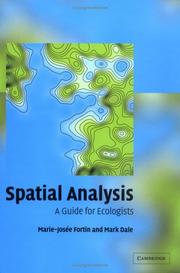| Listing 1 - 8 of 8 |
Sort by
|

ISBN: 1107112192 1280416734 9786610416738 0511173474 051115254X 0511325002 0511612583 0511052804 0511017588 9780511017582 0511037562 9780511037566 9780511152542 9780511173479 9780511052804 9780521452274 0521452279 0521452279 9781107112193 9781280416736 6610416737 9780511325007 9780511612589 9780521794374 0521794374 Year: 1999 Publisher: Cambridge New York Cambridge University Press
Abstract | Keywords | Export | Availability | Bookmark
 Loading...
Loading...Choose an application
- Reference Manager
- EndNote
- RefWorks (Direct export to RefWorks)
The predictability of the physical arrangement of plants, at whatever scale it is viewed, is referred to as their spatial pattern. Spatial pattern is a crucial aspect of vegetation which has important implications not only for the plants themselves, but also for other organisms which interact with plants, such as herbivores and pollinators, or those animals for which plants provide a habitat. This book describes and evaluates methods for detecting and quantifying a variety of characteristics of spatial pattern. As well as discussing the concepts on which these techniques are based, examples from real field studies and worked examples are included, which, together with numerous line figures, help guide the reader through the text. The result is a book that will be of value to graduate students and research workers in the fields of vegetation science, conservation biology and applied ecology.
Plant ecology --- Spatial analysis (Statistics) --- Analysis, Spatial (Statistics) --- Correlation (Statistics) --- Spatial systems --- Botany --- Phytoecology --- Plants --- Vegetation ecology --- Ecology --- Statistical methods. --- Floristic ecology
Book
ISBN: 1107460972 9781107460973 110708931X 9781107089310 9781316105450 Year: 2017 Publisher: Cambridge Cambridge University Press
Abstract | Keywords | Export | Availability | Bookmark
 Loading...
Loading...Choose an application
- Reference Manager
- EndNote
- RefWorks (Direct export to RefWorks)
Graph theory can be applied to ecological questions in many ways, and more insights can be gained by expanding the range of graph theoretical concepts applied to a specific system. But how do you know which methods might be used? And what do you do with the graph once it has been obtained? This book provides a broad introduction to the application of graph theory in different ecological systems, providing practical guidance for researchers in ecology and related fields. Readers are guided through the creation of an appropriate graph for the system being studied, including the application of spatial, spatio-temporal, and more abstract structural process graphs. Simple figures accompany the explanations to add clarity, and a broad range of ecological phenomena from many ecological systems are covered. This is the ideal book for graduate students and researchers looking to apply graph theoretical methods in their work.
Book
ISBN: 110850597X 110851491X 1316105458 Year: 2017 Publisher: Cambridge : Cambridge University Press,
Abstract | Keywords | Export | Availability | Bookmark
 Loading...
Loading...Choose an application
- Reference Manager
- EndNote
- RefWorks (Direct export to RefWorks)
Graph theory can be applied to ecological questions in many ways, and more insights can be gained by expanding the range of graph theoretical concepts applied to a specific system. But how do you know which methods might be used? And what do you do with the graph once it has been obtained? This book provides a broad introduction to the application of graph theory in different ecological systems, providing practical guidance for researchers in ecology and related fields. Readers are guided through the creation of an appropriate graph for the system being studied, including the application of spatial, spatio-temporal, and more abstract structural process graphs. Simple figures accompany the explanations to add clarity, and a broad range of ecological phenomena from many ecological systems are covered. This is the ideal book for graduate students and researchers looking to apply graph theoretical methods in their work.
Ecology --- Graph theory. --- Research.

ISBN: 9780511542039 9780521804349 9780521009737 0511111355 9780511111358 0511111029 9780511111020 0511542038 1280415150 9781280415159 0521804345 0521804345 0521009731 0511324014 9780511324017 1107085632 9781107085633 1107131030 9781107131033 9786610415151 6610415153 0511197934 9780511197932 0511181310 9780511181313 9780521009731 9780521804345 Year: 2005 Publisher: Cambridge Cambridge University Press
Abstract | Keywords | Export | Availability | Bookmark
 Loading...
Loading...Choose an application
- Reference Manager
- EndNote
- RefWorks (Direct export to RefWorks)
The spatial and temporal dimensions of ecological phenomena have always been inherent in the conceptual framework of ecology, but only recently have they been incorporated explicitly into ecological theory, sampling design, experimental design and models. Statistical techniques for spatial analysis of ecological data are burgeoning and many ecologists are unfamiliar with what is available and how the techniques should be used correctly. This book gives an overview of the wide range of spatial statistics available to analyse ecological data, and provides advice and guidance for graduate students and practising researchers who are either about to embark on spatial analysis in ecological studies or who have started but are unsure how to proceed. Only a basic understanding of statistics is assumed and many schematic illustrations are given to complement or replace mathematical technicalities, making the book accessible to ecologists wishing to enter this important and fast-growing field for the first time.
Ecology --- Spatial analysis (Statistics) --- Analysis, Spatial (Statistics) --- Correlation (Statistics) --- Spatial systems --- Statistical methods. --- Spatial analysis (Statistics). --- Geografie --- Landschapskunde --- Ecologie. --- Ecologie --- Analyse spatiale (Statistique) --- Statistical methods --- Méthodes statistiques
Book
ISBN: 1108491847 9781108491846 1108740715 9781108740715 9781108649018 Year: 2021 Publisher: Cambridge Cambridge University Press
Abstract | Keywords | Export | Availability | Bookmark
 Loading...
Loading...Choose an application
- Reference Manager
- EndNote
- RefWorks (Direct export to RefWorks)
"Ecology is about understanding how organisms interact with other organisms and the environment they inhabit (i.e. fundamental and realised niches). It is easy to imagine an individual organism of any kind as a dot with all sorts of arrows impinging upon it, an arrow can represent abiotic factors (temperature, light, etc.), as well as many arrows for all the other organisms (biotic factors, intra- and inter-specific interactions) that affect it. Ecology aims therefore to determine the magnitude and rate associated with some of the arrows, and which are the most important and why. Each organism also has its own effects on the same list of factors, even if the effects may be small, so we can also imagine arrows going out from the same dot, one to each of the same list of factors (they can be dots too). Again, a challenge is to determine the associated weights and importance for the arrows, some of which are directed toward other organisms. As soon as we consider more than a single organism, even just a few, we immediately have a complex structure of dots and arrows: an ecological network! It is an obvious step to consider ecological systems as ecological networks, and as such to assess how network theory (concepts and methods) might be applied to them. Network theory and the mathematics of graph theory that underlie network analysis provide simple concepts that can applied to systems that are complex both in structure and dynamics. It is those concepts that allow us to provide a sorted set of methods for the quantitative analysis of 10 ecological networks, along with thoughts and advice on how best to proceed. Through the years, the need to take a network analysis framework to study complex system has arisen in many fields (physics, computer science, communication science (transportation, electricity, social), and bio- and ecoinformatics), and there is a challenging diversity of approaches, methods, and measures that should be understood, or at least sorted, before applying them to our own data. The overarching goal of this book is to help ecologists in selecting the appropriate network methods to represent, analyse, and model their ecological system using network theory."
Ecology - Statistical methods --- System analysis --- Quantitative research
Book
ISBN: 1139984497 1139989111 051197891X Year: 2014 Publisher: Cambridge : Cambridge University Press,
Abstract | Keywords | Export | Availability | Bookmark
 Loading...
Loading...Choose an application
- Reference Manager
- EndNote
- RefWorks (Direct export to RefWorks)
Nowadays, ecologists worldwide recognize the use of spatial analysis as essential. However, because of the fast-growing range of methods available, even an expert might occasionally find it challenging to choose the most appropriate one. Providing the ecological and statistical foundations needed to make the right decision, this second edition builds and expands upon the previous one by: • Encompassing the basic methods for spatial analysis, for both complete census and sample data • Investigating updated treatments of spatial autocorrelation and spatio-temporal analysis • Introducing detailed explanations of currently developing approaches, including spatial and spatio-temporal graph theory, scan statistics, fibre process analysis, and Hierarchical Bayesian analysis • Offering practical advice for specific circumstances, such as how to analyze forest Permanent Sample Plot data and how to proceed with transect data when portions of the data series are missing. Written for graduates, researchers and professionals, this book will be a valuable source of reference for years to come.
Ecology --- Spatial analysis (Statistics) --- Statistical methods.
Book
ISBN: 1108632971 1108649017 Year: 2021 Publisher: Cambridge : Cambridge University Press,
Abstract | Keywords | Export | Availability | Bookmark
 Loading...
Loading...Choose an application
- Reference Manager
- EndNote
- RefWorks (Direct export to RefWorks)
Network thinking and network analysis are rapidly expanding features of ecological research. Network analysis of ecological systems include representations and modelling of the interactions in an ecosystem, in which species or factors are joined by pairwise connections. This book provides an overview of ecological network analysis including generating processes, the relationship between structure and dynamic function, and statistics and models for these networks. Starting with a general introduction to the composition of networks and their characteristics, it includes details on such topics as measures of network complexity, applications of spectral graph theory, how best to include indirect species interactions, and multilayer, multiplex and multilevel networks. Graduate students and researchers who want to develop and understand ecological networks in their research will find this volume inspiring and helpful. Detailed guidance to those already working in network ecology but looking for advice is also included.
Ecology --- Quantitative research. --- System analysis. --- Statistical methods.
Book
ISBN: 9780511978913 9780521194303 9780521143509 Year: 2014 Publisher: Cambridge Cambridge University Press
Abstract | Keywords | Export | Availability | Bookmark
 Loading...
Loading...Choose an application
- Reference Manager
- EndNote
- RefWorks (Direct export to RefWorks)
| Listing 1 - 8 of 8 |
Sort by
|

 Search
Search Feedback
Feedback About UniCat
About UniCat  Help
Help News
News